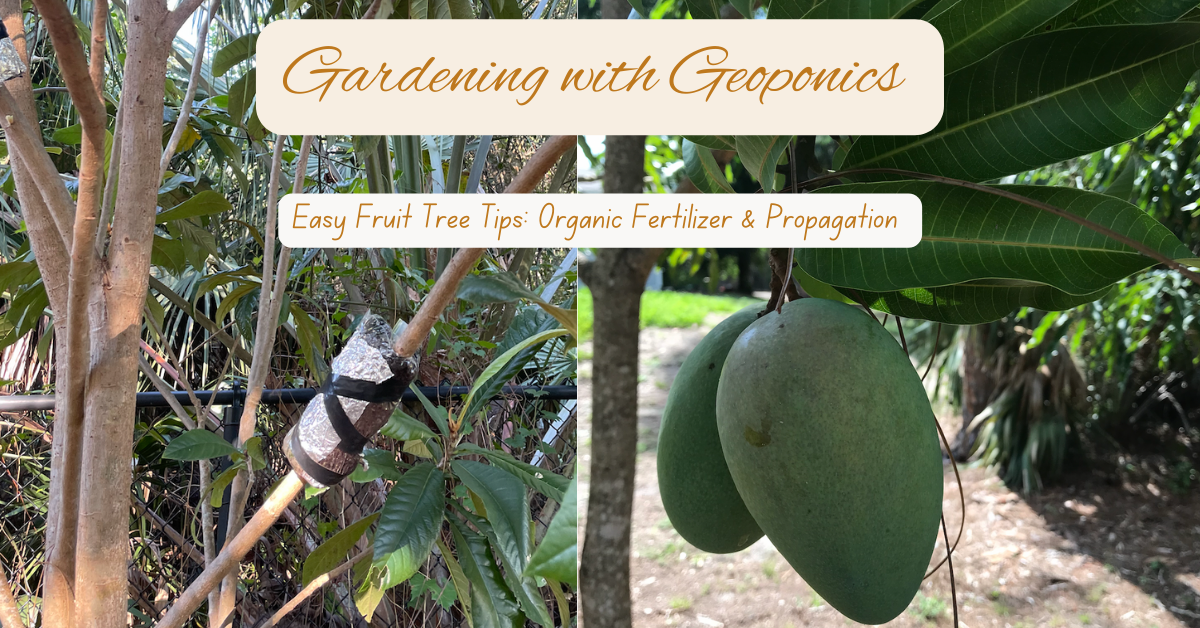Propagating and Organic Fertilizer for Fruit Trees
Gardening with Geoponics got interesting this week when we branched out to explore expert tips about propagating fruit trees. We learned how easy and quick it is to propagate many fruit trees using the air layer method. And, we swapped organic fertilizer tips with other expert growers.
About the Air Layer Method of Propagating Fruit Trees
First, you can get a new tree in 8 weeks and a fruiting tree within one growing season using air layer. This isn’t a new method, but we were learning from a fruit tree grower in Golden Gate Estates, Florida. He didn’t want to share his full name, but he was happy to share his knowledge.
Some trees take longer, but nearly all can be air layered. Maybe you’ve heard of how a branch cutting or root cutting from some trees can be used to create new trees. For example, mango trees and many other tree varieties can be propagated this way. However, afterward, it can take years to get a fruit. But did you know there is another way?
You can grow a new tree right on the attached branch of an existing tree. That branch may even fruit right away. This is called air layer.
What’s exciting about this method is that the new tree, once rooted and established, acts the age of the original tree. That means a much shorter waiting period for fruiting.
Many trees are capable of air layering. In fact, almost all trees can be air layered. Some are just faster to air layer than others. These faster varieties for air layering include some variety of apple, and especially sapote, lychee, fig, Persian lime and many more.
How Does Air Layering Work?
The branch of an existing mature tree is wrapped in peat moss, or similar, and treated with a hormone to encourage rooting. Sometimes this mixture is attached simply with plastic and tape so it can withstand most weather.
Within the peat moss or other material attached to the tree, a rooting hormone is used. This can be as simple as using cinnamon, apple cider vinegar, honey, saliva or a commercial hormone. Saliva? Yes!
In the faster to air layer species of trees, roots will be grown within about 8 weeks.
Once there are roots in the peat moss mixture, there will also be new tree branches sprouting out below the air layer area.
What’s essentially happened is the tree has been tricked to act as if part of its branch is underground. In its survivalist ways, the tree grows new branches in the air and new roots. The tree is growing as if its limb is partially underground, due to the peat moss mix wrapped around its mature branch.
Advantages of Air Layer Fruit Trees
- Takes about 8 weeks for roots to establish on a living, connected branch of the mother tree. Some tree species take longer.
- Meanwhile, the existing tree grows new small limbs just below the air layer.
- The new tree’s roots are ready to plant just by cutting between those roots and the new shoots growing from the existing branch.
- The new tree is likely to fruit as quickly as one season or one year, depending on the air layering timing. This can save a decade of waiting for fruit!
Well, hopefully this sprouted your interest. Now, you can research further any tree you’d like to try to propagate using the air layer method.
How to Keep Fruit Trees Healthy & Fruiting
Part of propagating a fruit tree is also giving it the nutrition, water and condition it needs. Research to put your tree in the best possible place in terms of amount of sun or shade. Water trees and mulch around the trunk of the tree but allow some space so the mulch is not touching the tree.
Water around the base of the tree as far wide in circumference as the tree’s branches.
Fertilizing Your Fruit Tree Organically
Adding Homemade Fertilizer Ingredients
Fruit trees may have some variables in terms of nutritional needs. Overall, however, most will need N-P-K. Those are nitrogen, phosphorus and potassium. It’s quick to research species’ needs, but a safe bet is to get an even amount of each. Some soil is more depleted than others. Generally, manure and compost will help nourish soil.
One of our favorite ways to fertilize organically is to use FertaFlow organic fish fertilizer. Then, we can complement that organic fish fertilizer with other inexpensive organic home products. This is great for overcoming chemical fertilizer shortages, increased expenses and runoff pollution.
For example, we use wood ash for extra potassium, especially for banana trees that need help fruiting or have yellowing leaves. This comes from our Golden Gate Estates fruit tree expert. For nitrogen, which almost all fruit trees need, use coffee grounds, longtime growers suggest. Choose decaf to lower pH and regular to increase it a bit. The alternative is urine. Female urine for a bit higher pH and male for lower pH. But with saliva and urine, many people get a bit grossed out. So, stick with coffee and honey, or whatever helps you enjoy the fruits of your labor.
Also, we are increasing organic matter with these and other compost ingredients. Alternative to compost, or in addition to some of these home organic fertilizers, use SoilPlex for a similar effect to a liquid compost. But, most of all, SoilPlex is rich in humic and fulvic acids. These will increase nutrient uptake, soil’s water holding capacity, and carbon in soil. These are just three of the benefits of SoilPlex, but there is more if you look to this blog for details.
Both of these, SoilPlex and FertaFlow, are OMRI listed for organic growing. They are very affordable, easy to use liquid concentrates and available on ShopGeoponics.com. They are among the most sustainable and environmentally friendly products available to improve soil and plant health while increasing yields.

